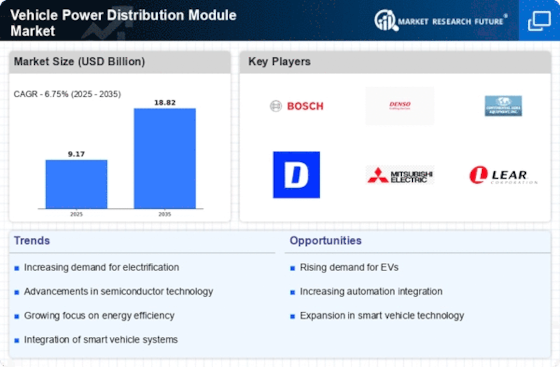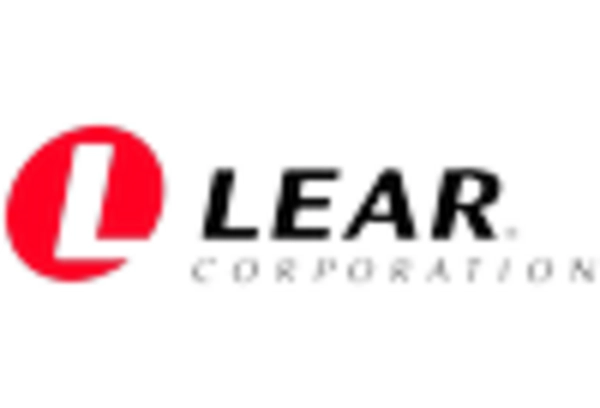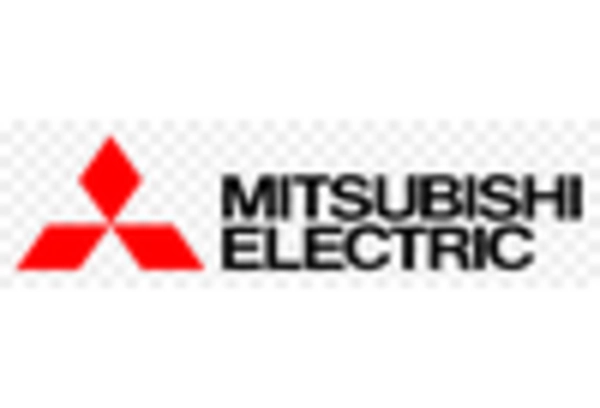Rising Demand for Electric Vehicles
The increasing consumer preference for electric vehicles (EVs) is a pivotal driver for the Vehicle Power Distribution Module Market. As more manufacturers pivot towards electrification, the demand for efficient power distribution systems rises. In 2025, it is estimated that EV sales will account for over 30% of total vehicle sales, necessitating advanced power distribution modules to manage energy flow effectively. This shift not only enhances vehicle performance but also aligns with global sustainability goals. Consequently, the Vehicle Power Distribution Module Market is likely to experience substantial growth as automakers seek to integrate these modules into their EV designs.
Growth of Autonomous Vehicle Technology
The emergence of autonomous vehicle technology is reshaping the Vehicle Power Distribution Module Market. Autonomous vehicles rely heavily on sophisticated electronic systems that demand efficient power distribution to function optimally. As the development of self-driving technology accelerates, the need for advanced power distribution modules becomes increasingly critical. By 2025, it is anticipated that the market for autonomous vehicles will expand significantly, driving demand for innovative power management solutions. This evolution presents a unique opportunity for the Vehicle Power Distribution Module Market to cater to the specific needs of autonomous vehicle manufacturers.
Increased Focus on Vehicle Safety Features
The heightened emphasis on vehicle safety features is driving the Vehicle Power Distribution Module Market. Modern vehicles are increasingly equipped with advanced safety technologies, such as collision avoidance systems and automated driving aids, which require reliable power distribution systems. The integration of these features necessitates robust power management solutions to ensure consistent performance. As safety regulations become more stringent, manufacturers are compelled to invest in high-quality power distribution modules. This trend is expected to contribute to a steady growth trajectory for the Vehicle Power Distribution Module Market, as automakers prioritize safety alongside performance.
Regulatory Pressures for Emission Reductions
Regulatory pressures aimed at reducing vehicle emissions are a key driver for the Vehicle Power Distribution Module Market. Governments worldwide are implementing stringent emission standards, compelling manufacturers to adopt cleaner technologies. This regulatory landscape encourages the development of more efficient power distribution systems that can support hybrid and electric vehicles. As automakers strive to comply with these regulations, the demand for advanced power distribution modules is expected to rise. By 2025, the Vehicle Power Distribution Module Market is likely to witness increased investments in technologies that facilitate compliance with emission standards, thereby enhancing market growth.
Technological Advancements in Power Management
Technological innovations in power management systems are significantly influencing the Vehicle Power Distribution Module Market. The advent of smart power distribution modules, which utilize advanced algorithms for energy management, is enhancing vehicle efficiency and safety. These modules are designed to optimize energy usage, thereby extending battery life and improving overall vehicle performance. As of 2025, the market for these advanced modules is projected to grow at a compound annual growth rate (CAGR) of approximately 8%. This trend indicates a robust demand for sophisticated power distribution solutions, further propelling the Vehicle Power Distribution Module Market.


















Leave a Comment